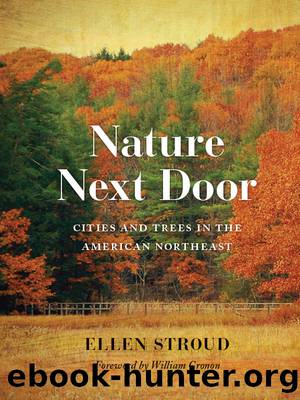Nature Next Door by Stroud Ellen;Cronon William;Cronon William;

Author:Stroud, Ellen;Cronon, William;Cronon, William;
Language: eng
Format: epub
Publisher: University of Washington Press
CHAPTER FOUR
Who Owns Maine's Trees?
In May 1895, Cornelia âFly Rodâ Crosby sat tying flies in a Maine cabin, admiring the mounted deer and moose heads that adorned the cabin walls and handing out pamphlets to passersby. The cabin was a modest one, a mere ten-by-thirteen-foot structure of peeled logs, but it caught everyone's eye. In the woods of Maine, it would have been no strange sight; in Manhattan's Madison Square Garden, it was decidedly odd.1
The cabin and a nearby lean-to, both decorated with antlers, stuffed rabbits, birds, fish, snowshoes, and guns, were part of the Maine exhibit at the first annual New York City Sportsmen's Exhibition. Crosby, an expert hunter and fisher and a tireless promoter of tourism in her home state, was part of the official Maine delegation to the show, and she reveled in showing New Yorkers what life in Maine could be like. For four days, she and her friends Ed Grant and James Mathieson, both Maine hunting guides, handed out leaflets and magazines touting Maine as the âplayground of a nationâ and demonstrating their backwoods skills. They were a hit and returned to Maine in high spirits with even grander plans for 1896. That next year, they borrowed a specially made railroad car to bring live fish for the display.2
In Vermont, forests were entangled with an image of romantic farm retreats; in Maine, they were tied to the romance of the wild. The Maine woods were harsh, as Henry David Thoreau had discovered on his own travels there in 1846: âNature here was something savage and awful, though beautifulâ¦. This was that Earth of which we have heard, made out of Chaos and Old Night.â3 The chaotic harshness had an appeal. When âFly Rod,â Grant, and Mathieson packaged the Maine landscape for New York tourists, they offered a challenge. The Maine woods promised rough living, large game, elusive trout, largemouth bass, and wild excitement. Maine was a place to get lost in the woods, to live off the land, to hone skills with rod and gun and knife.
Or so it seemed. This image of rugged individualism belied a different reality: Crosby was marketing her Manhattan Maine cabin as part of her state's effort to restrict and control the public use of land. The Chamber of Commerce wanted New Yorkers and other urban swells to come to Maine not to set out on their own in the woods but to hire guides who would manage their experiences in hunting camps. They would bring money into the state, but without threatening the valuable forests owned by the giant timber companies.
Fannie Hardy, a naturalist and also an avid hiker and hunter, thought Crosby had it all wrong. More tourists in Maine would mean more rules and more regulationsârules like hunting seasonsâthat would make it harder for the people of Maine to make use of resources that were rightly theirs. Traditionally, Maine residents had access to timber company land for hiking and hunting; urban tourists who didn't know what they
Download
This site does not store any files on its server. We only index and link to content provided by other sites. Please contact the content providers to delete copyright contents if any and email us, we'll remove relevant links or contents immediately.
| Fisheries & Aquaculture | Forests & Forestry |
The Lonely City by Olivia Laing(4624)
Animal Frequency by Melissa Alvarez(4239)
All Creatures Great and Small by James Herriot(4074)
Walking by Henry David Thoreau(3762)
Exit West by Mohsin Hamid(3690)
Origin Story: A Big History of Everything by David Christian(3525)
COSMOS by Carl Sagan(3420)
How to Read Water: Clues and Patterns from Puddles to the Sea (Natural Navigation) by Tristan Gooley(3303)
Hedgerow by John Wright(3174)
How to Do Nothing by Jenny Odell(3149)
The Inner Life of Animals by Peter Wohlleben(3147)
How to Read Nature by Tristan Gooley(3142)
Project Animal Farm: An Accidental Journey into the Secret World of Farming and the Truth About Our Food by Sonia Faruqi(3075)
Origin Story by David Christian(3050)
Water by Ian Miller(3028)
A Forest Journey by John Perlin(2960)
The Plant Messiah by Carlos Magdalena(2796)
A Wilder Time by William E. Glassley(2736)
Forests: A Very Short Introduction by Jaboury Ghazoul(2717)
